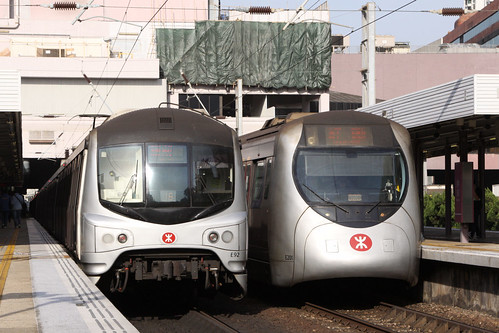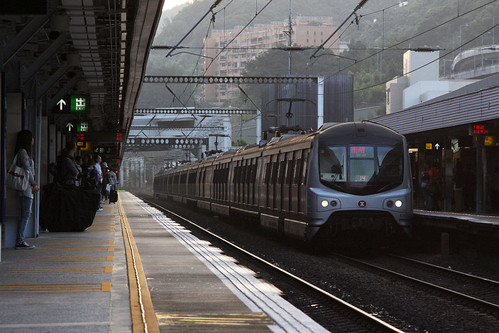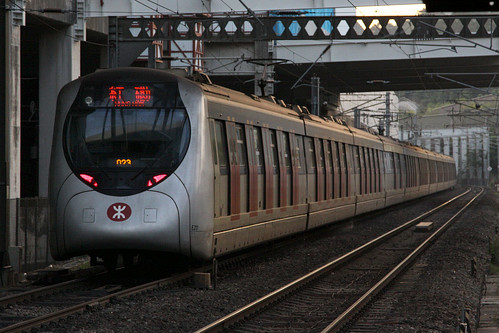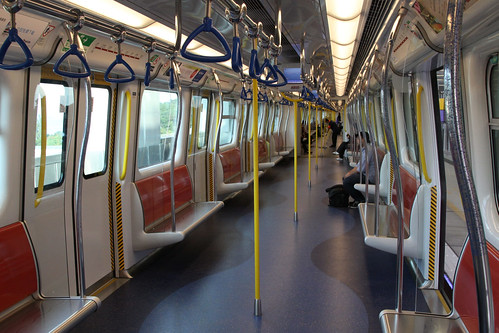On Monday I took you on a guided tour along the East Rail line – but what about the MTR trains that run along it? Today they are are the longest EMUs in Hong Kong, being 12-cars long, while other lines only use train sets up to 8-cars long. But what else sets them apart from the rest of the fleet?
Two classes of EMU are used to provided the MTR service: both types are identical from a functional perspective, each carriage having five doors per side and longitudinal seating, with the exception of one carriage – I’ll get to that one later! Side by side the styling differences are quite apparent, with the refurbished Metro Cammell unit on the left, and the streamlined looking SP1900 set on the right.
The Metro Cammell EMU fleet forms to core of the East Rail fleet, with 29 12-car long sets in service today, having received a mid life refurbishment by Alstom between 1996 and 1999. Originally ordered as part of the modernisation of the Kowloon Canton Railway, the first trains were delivered from 1982 having been manufactured at the Metro Cammell plant in Birmingham, England. Further units were ordered in 1986 and 1990, taking the total number of carriages built to 351.
The EMUs were initially formed as 3-car long sets, except for the final order when 6-car sets were specified. End communication doors were provided in the cab cars, permitting longer trains to be formed, up to 12-cars long. This 1998 photo by Joseph K.K. Lee shows a Metro Cammell EMU in original condition, with at least three 3-car sets forming the train. The yellow cab resulted in the nickname “yellow head” being given to them.

Photo by Joseph K.K. Lee / gakei.com
The Metro Cammell trains were original built with two different styles of interior layout: one for the inner suburban service as far as Sha Tin, and the other with toilets and luggage areas for the outer suburban service towards the border crossing at Lo Wu. As this 1992 photo by Joseph K.K. Lee shows, the interior does not look like a mass transit vehicle, with each carriage having a reasonable number of seats and three doors per side.

Photo by Joseph K.K. Lee / gakei.com
Promotions for the KCR during this period also emphasised the “travel” nature of the service, not the everyday home to work commute.
By the mid-1990s patronage on the railway had skyrocketed with the development of the New Towns along the route, so a decision was made to refurbish the fleet to mass transit standards. The work was carried out by Alstom between 1996 and 1999, and resulted in the look seen on the trains today.
The exterior changes included the formation of the carriages into fixed 12-car sets, the elimination of the end communication doors from the driving cabs, removal of toilets and luggage areas from the passenger saloon, and increasing the number of doors per carriage from 3 to 5 per side.
A more disruptive change for passengers was the mass removal of seats, with the side by side seating replaced by longitudinal benches along the carriage walls, to allow for more standing room. Along with the increased number of doors, this gave the refurbished KCR trains the same passenger handling ability as trains on the MTR underground lines.
Despite converting East Rail into a metro style rail service, continued patronage growth resulted in the need for additional train sets, achieved in 2001 with the delivery of the “SP1900” EMU fleet. Built by the Japanese firms of ITOCHU, Kinki Sharyo and Kawasaki Heavy Industries, only eight 12-car train sets were built for the East Rail line, but the same design was used for the trains delivered for the KCR’s later West Rail and Ma On Shan Rail projects.
The interior followed the metro layout of the refurbished trains, with the same door spacing, and longitudinal seating. (this photo is from inside a Ma On Shan line SP1900 train, since I never got a good shot inside the East Rail version)
Despite their transformation made to the KCR since electrification, trains on the East Rail line still have one small element tying them back to their suburban roots: their first class compartments.
It is an interesting option for passengers, given the longest possible end-to-end travel time is just on 40 minutes, why do people decide to pay the extra for first class?
Stay tuned for the answer in a later post… travelling first class on the MTR








Just a point of interest, East Rail trains will be reduced to 9 cars following the opening of the Shatin-Central Link, due to geotechnical difficulties in platform building on HK island.
What a shame 🙁
The ‘geotechnical difficulties’ line sounds like a bit of a cop-out from the MTR so they can build a cheaper railway, while finding space to build a 12-car long platform in the middle of Hong Kong Island is difficult, they did manage to build one in the very confined location at East Tsim Sha Tsui – the resulting platform was 291 metres long and dead straight. (here is a paper by the engineers behind that project)
At first glance it seems that the move for shorter 9-car trains will make the line more congested, but overall there will be more trains running – the MTR gives some good reasons in their FAQ on the Shatin to Central Link page (find it here). In short, the passengers from Ma On Shan that currently travel on East Rail will have their own route to Hung Hom via another Kwun Tong line interchange station at Diamond Hill, and with the Express Rail Link coming soon intercity trains will be taken off East Rail freeing up paths for additional MTR services.
The only thing left to consider is what will happen to the extra carriages on East Rail trains, and if first class will be retained. The refurbished Metro Cammell sets might be retired by the time the line is extended to Hong Kong Island in 2020, and the extra cars from the SP1900 trains could be used to build up the 4-car long sets on the Ma On Shan Line to their final 8-car length.
Still, those 12-car long trains are nice to photograph, I’ll miss them when they’re gone.
Thanks for coming up with such an in-depth article on the railway I take every day. It’s becoming more monotone today compared to the days when traveling on the ‘train’ was an exciting childhood experience. A great chance to look back at those childhood days
Hi Hayden,
It feels that over in Australia the same thing is happening with our railways – everything new is boring and unexciting. I wonder if it is just a nostalgia for the ‘olden days’, or a lack of anything new and exciting being brought in.
Here’s a picture of the original Metro Cammell train being produced. Also note the MTR Metro Cammell train behind: http://www.uwants.com/viewthread.php?action=printable&tid=3497999
Hi Herb,
Thanks for the link – I’ve found a few more early East Rail photos from the same source.
Building the trains:
http://gordon_graham.rrpicturearchives.net/showPicture.aspx?id=651981
http://gordon_graham.rrpicturearchives.net/showPicture.aspx?id=651982
Delivery to the wharf at Hung Hom:
http://gordon_graham.rrpicturearchives.net/showPicture.aspx?id=651978
http://gordon_graham.rrpicturearchives.net/showPicture.aspx?id=651977
And ready for road transport:
http://gordon_graham.rrpicturearchives.net/showPicture.aspx?id=651979
First class interior:
http://gordon_graham.rrpicturearchives.net/showPicture.aspx?id=651999
And standard class:
http://gordon_graham.rrpicturearchives.net/showPicture.aspx?id=651996
Thanks for those links! They are really obscure when I search for such images on Google.
Luckily the photos were watermarked, so I could trace them back to the original source.
Here is a sneak preview of the new Hyundai Rotem trains that will replace the Metro Cammell trains sometime in 2018-20 (link is only in Korean, sorry):
These will be 9 cars instead of 12 and there will still be a 1st class car
https://www.hyundai-rotem.co.kr/PRCenter/News_View.asp?type=%EC%A3%BC%EC%9A%94%EC%86%8C%EC%8B%9D&idx=1765
This forum link also shows the mockup of the new train (scroll down to the middle):
http://www.discuss.com.hk/viewthread.php?tid=24644088
Interesting to see that the 1st class cars will be retained – with the shorter consists, it will make up a larger proportion of each train.
Apparently the new trains will replace the Metro Cammell fleet, but what about the existing SP1900 trains? Following the move to 9-car trains there will be extra non-driving cars – use them to lengthen the existing 4-car sets on the Ma On Shan line, or just put them into storage?
The existing Sp1900 trains will be used to lengthen the Ma On Shan Line trains, so we won’t have 2 types of trains on the Ma On Shan Line.
Thanks for that info.
3 steps:
1) Remove the F car (it’s still unclear how they’ll be dealt with)
2) Of the 11 remainder cars, 3 are moved to the MOL trainsets (Marcus Wong has given us a really good diagram on it – check out the article “Turning MTR railcars around by crane”)
3) These 8-car sets will be withdrawn from the ERL and run on the Tuen Ma Line instead, alongside the extended WRL and MOL sets.
Here is the post about the reshuffling of the SP1900 trains:
https://www.checkerboardhill.com/2017/11/turning-mtr-railcar-with-crane/
Pingback: Platform gap fillers on the MTR East Rail line - Checkerboard Hill
Out of curosity, do you know if the old East Rail trains can physically run on the West Rail line?
I’m not 100% sure – there is a track connection at Hung Hom, but I’ve only seen SP1900 trains moved between the two lines. A diesel locomotive is needed to transfer the trains due to the incompatible signalling systems.
https://www.checkerboardhill.com/2017/01/mtr-sp1900-train-diesel-locomotive-hauled/
As far as I know, these 12-car trains are the longest subway trains in the world. But no one really documents subway systems by train length – everyone’s just interested in the system and track length. Will be sad to see them go.
I found some discussion on the “longest train” topic here:
https://www.quora.com/What-is-the-metro-with-the-longest-operating-trainsets-in-the-world-For-example-New-York-City-has-some-11-car-trainsets-that-are-600ft-in-length
Examples include:
– 560 feet: New York City Subway with eleven 50 foot R188 cars,
– 600 feet: New York City Subway with ten 60 foot cars,
– 700 foot: BART with ten 70-foot cars.
Both examples are up there with the ‘standard’ 8-car long / 23 metre carriage metro trains seen in Hong Kong and China, which are around 188 metres / 615 feet long.